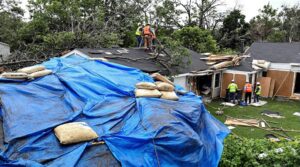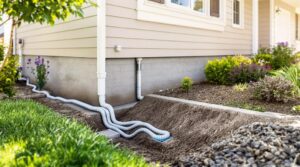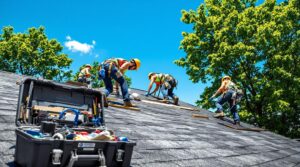Mitigating structural damage requires a thorough approach that involves identifying and addressing the root causes of damage. This includes distinguishing between structural and non-structural damage, and recognizing signs of structural damage such as cracked concrete and bulging walls. Environmental factors and material defects also contribute to damage. A thorough evaluation by licensed professionals is necessary to detect early signs of damage and recommend necessary repairs. Further exploration of damage mitigation strategies can reveal additional key considerations.
Key Takeaways
- Identify and address structural damage signs, such as cracked concrete, bulging walls, and misaligned doors/windows, promptly to prevent catastrophic failures.
- Regular inspections by licensed professionals can help detect early signs of damage and recommend necessary repairs to maintain structural integrity.
- Compliance with local building codes, such as the IEBC 2024, and quality materials selection can enhance structural resilience against environmental factors.
- Proactive maintenance plans involving biannual inspections and routine checks for roofs, plumbing, and landscaping can prevent leaks and water intrusion.
- Engaging public adjusters can strengthen insurance claims, secure fair compensation for visible and hidden damages, and increase settlements by 20-50%.
Assessing Building Damage Types and Causes
When conducting a building damage assessment, it is essential to distinguish between structural and non-structural damage to determine the overall integrity and safety of the building.
Structural damage primarily affects load-bearing components, such as foundations, walls, beams, and roofs, while non-structural damage impacts aesthetics and functionality. A thorough assessment of both types of damage is vital for accurate insurance claims and mitigation efforts.
Environmental factors like extreme temperatures, heavy rainfall, and seismic activities can greatly contribute to building damage. Ground movements, including soil settlement and landslides, also pose a direct threat to building stability.
Material defects, such as the use of poor-quality materials, can weaken structures over time. Identifying the causes and types of damage informs effective mitigation strategies and guarantees a safe and resilient building.
Working with public adjusters on damage claims can increase settlement amounts by 30-50% compared to filing independently.
Identifying and Addressing Structural Damage
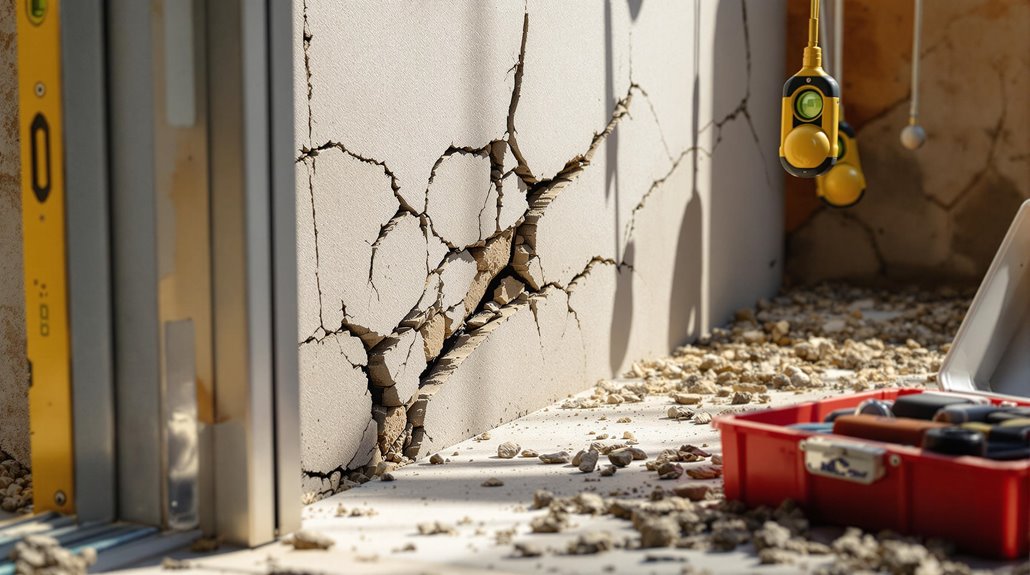
Recognizing signs of structural damage is essential for timely intervention, with indicators such as cracked concrete, bulging walls, and misaligned doors and windows often signaling underlying foundation issues.
A detailed assessment of structural integrity should follow the identification of these signs, taking into account environmental factors and potential seismic activities that may have contributed to the damage.
Recognizing Damage Signs
Structural integrity is a vital aspect of any building, and identifying signs of damage is essential to preventing catastrophic failures. Recognizing damage signs is a significant step in mitigating structural damage.
The following indicators may signal underlying structural issues:
- Cracked concrete: particularly at junctions or around load-bearing walls, can indicate potential structural shifts.
- Water leaks: especially in basements or near foundations, can compromise structural integrity and lead to mold growth.
- Misaligned doors and windows: may signal underlying foundation issues, which can manifest as uneven floors or wall bulges.
- Bulging or bowed walls: should not be ignored, as they may indicate serious issues that could compromise the safety of the building.
Regular inspections can help detect these signs and prevent further structural damage. Working with professional adjusters can lead to more thorough damage assessments and significantly higher settlement amounts for structural repairs.
Assessing Structural Integrity
Careful evaluation of a building’s condition is the first step in evaluating its structural integrity.
To determine potential safety risks and identify areas for improvement, look for signs such as cracked concrete, misaligned doors, and bowed walls. Regular visual inspections can catch early signs of damage, but professional assessments are necessary to uncover hidden issues.
Noting environmental factors like extreme temperatures, heavy rainfall, and seismic activities can help in ongoing maintenance. This evaluation will also inform insurance-related decisions, providing financial protection against unforeseen damage.
Not addressing these issues can lead to significant financial losses. A licensed professional can provide urgent evaluation to assess damage and recommend necessary repairs. Working with public adjusters can increase property damage claim settlements by 30-50% when structural issues require insurance claims.
Importance of Professional Assessments and Insurance Claims

Numerous factors contribute to the success of a structural damage mitigation effort, and foremost among them is the engagement of licensed professionals to conduct thorough assessments.
Professional assessments provide critical documentation that supports insurance claims and guarantees accurate repair designs.
The following key considerations highlight the importance of professional assessments in the insurance claims process:
- Validated Claims: Insurance companies respond more favorably to claims supported by licensed professionals’ assessments.
- Comprehensive Evaluations: Early professional involvement identifies hidden structural damage that may not be immediately visible.
- Upfront Costs: Property owners should be prepared to cover initial assessment costs prior to receiving insurance funds.
- Timely Communication: Prompt communication with insurance providers, coupled with professional assessments, markedly influences the outcome of repair funding.
Claims determination typically requires 30-60 days for insurance adjusters to process and validate submitted documentation.
Understanding Substantial Structural Damage Criteria
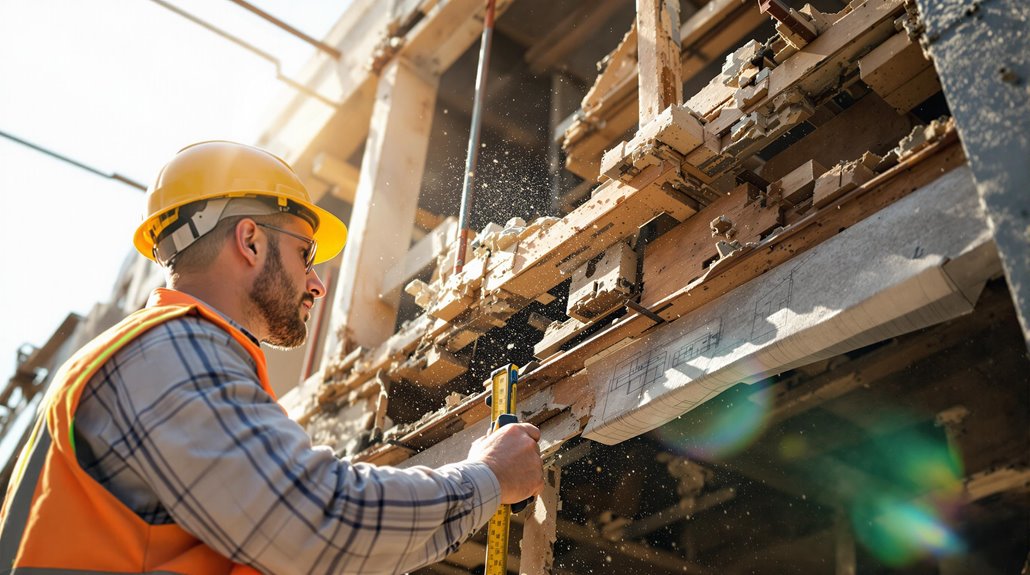
When evaluating the extent of damage to a building, understanding the Substantial Structural Damage (SSD) criteria, as defined by the International Existing Building Code (IEBC), is fundamental for ensuring that repairs meet current codes and safety standards.
Substantial structural damage is defined by specific thresholds, including over 33% reduction in lateral force-resisting system capacity, a 20% reduction in gravity load-carrying components with remaining capacity below 75%, and similar thresholds for snow load-carrying systems.
Compliance with SSD criteria necessitates repairs that restore or retrofit damaged components to meet current codes. Accurate engineering analyses play an important role in evaluating SSD, determining specific load capacities and guiding necessary interventions.
Understanding SSD criteria is significant for engineers and contractors, as it influences the scope, design, and permitting of repairs.
Navigating Code Compliance and Repair Protocols
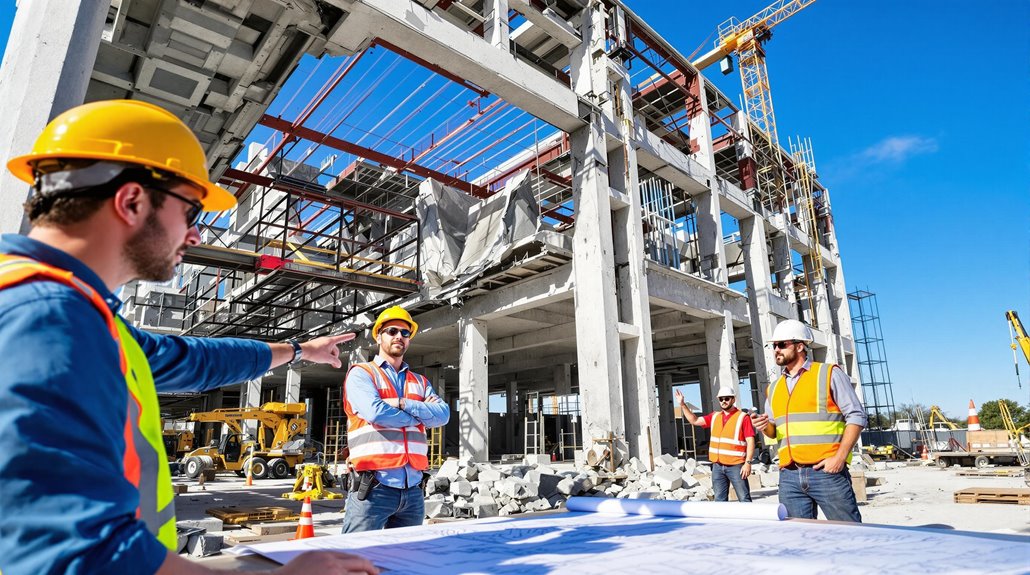
Following identification of substantial structural damage (SSD), compliance with the International Existing Building Code (IEBC) 2024 is vital for determining necessary repair actions.
This code outlines specific criteria that must be met to guarantee that repairs comply with the latest building codes and are performed by registered professionals.
The following critical factors must be considered:
- Threshold Calculation: Calculate the reduction in lateral force-resisting capacity or gravity load-carrying components to confirm the presence of SSD.
- Permitting Process: Guarantee the correct permitting process is completed to comply with code upgrades and avoid potential fines or non-compliance.
- Professional Expertise: Hire a qualified and registered engineer or contractor to oversee the repair project and facilitate maintaining communication with the insurance company.
- Restoration Scope: Determine the scope of the restoration project based on the SSD criteria to prevent unnecessary costs or underestimates.
Working with independent insurance agents can provide valuable guidance through multiple company comparisons and personalized service during the repair process.
Preventative Measures for Building Damage and Maintenance

Effective prevention of building damage requires a combination of regular inspections, quality materials selection, and proactive maintenance plans.
Biannual building inspections play an essential role in identifying potential vulnerabilities before they escalate into major structural problems.
Having licensed professionals assess the property ensures thorough documentation and proper evaluation of any existing or potential damage.
Regular Building Inspections
What role do regular building inspections play in maintaining the structural integrity of a building? They are essential in identifying early signs of damage, preventing more extensive repairs later on.
Regular building inspections should be conducted at least annually to evaluate the building’s condition and identify potential issues.
Some key aspects to take into account during regular building inspections include:
- Roof evaluations: Inspect for damaged or missing roofing materials, signs of wear, and leaks.
- Foundation assessments: Check for cracks, shifts, or water damage that can compromise the building’s stability.
- Plumbing inspections: Identify leaks, corrosion, and other issues that can cause water damage or structural problems.
- Landscaping evaluations: Guarantee proper drainage and grading to prevent water accumulation and potential structural damage.
Quality Materials Selection
Structural resilience is heavily influenced by the quality of materials used in a building’s construction. Selecting high-quality building materials can greatly enhance a structure’s resistance to environmental factors, such as extreme temperatures and heavy rainfall, reducing the likelihood of damage.
Materials with proven durability, like treated wood, reinforced concrete, and high-grade steel, minimize long-term wear and tear, ultimately lowering maintenance and repair costs. Weather-resistant materials, including impact-resistant windows and roofing, prevent water intrusion and structural damage during severe weather events.
Investing in quality materials extends the building’s lifespan and reduces costly repairs. Understanding local climate challenges and choosing materials designed to withstand those conditions further protects a building’s integrity and enhances overall safety, making quality materials selection a vital aspect of structural damage mitigation.
Proactive Maintenance Plans
While quality materials selection is crucial for building resilience, implementing proactive maintenance plans is equally essential for preventing damage and guaranteeing the long-term integrity of a structure.
Proactive maintenance plans involve regular inspections and checks to identify potential issues before they become major problems.
Some key components of a proactive maintenance plan include:
- Regular inspections: Conduct inspections at least twice a year to identify early signs of damage, such as cracks or water leaks.
- Roof and plumbing checks: Prevent water intrusion and leaks by conducting routine checks.
- Climate-specific maintenance: Tailor plans to local climate challenges, such as extreme temperatures or heavy rainfall.
- Proactive landscaping: Confirm trees are planted at a safe distance from the foundation to prevent root damage and soil erosion.
Regular maintenance is essential since standard insurance policies typically exclude lack of maintenance related issues from coverage.
Mine Planning, Design, and Reclamation for Structural Safety
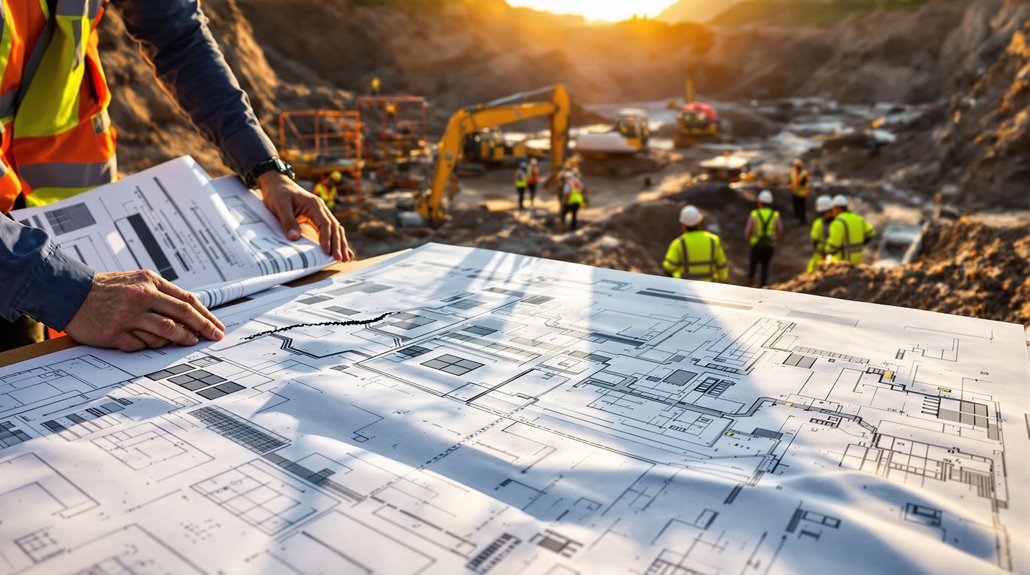
In regions where mining activities are prevalent, prioritizing mine planning and design is essential to minimize the risks associated with land subsidence, vibrations, and other environmental impacts that may compromise the structural integrity of nearby buildings.
Effective mine planning requires extensive risk assessments to guarantee structural safety during and after mining operations. Collaboration with mining companies is also vital to understand environmental impacts.
Reclamation plans should prioritize soil preservation and restoration to maintain structural integrity post-mining activities. By implementing effective water management strategies, risks related to waterlogging and potential natural disasters can be mitigated.
Architects and engineers must be aware of mining operations and their impacts on structural safety to design and construct resilient structures in mining regions.
Proactive Strategies for Maximizing Insurance Claims and Recovery
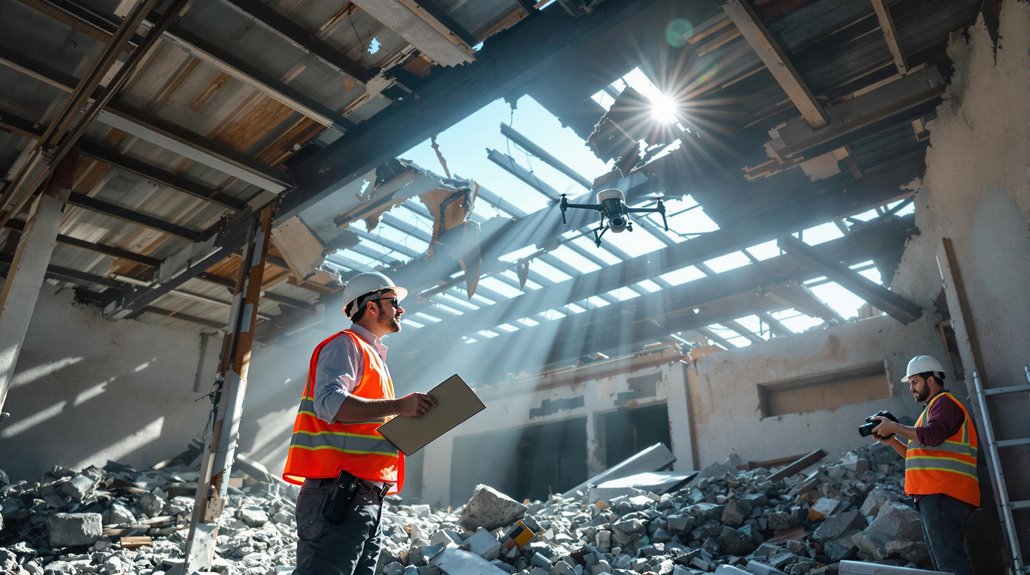
Following thorough assessments and planning for mitigating structural damage, taking proactive measures to navigate insurance claims can help expedite recovery efforts for those impacted.
Working with a public adjuster increases settlements by 20-50% compared to handling claims independently.
To maximize insurance claims and recovery, consider the following strategies:
- Engage licensed professionals: Seek professional help from structural engineers to guarantee accurate documentation of damage, which is essential for supporting claims.
- Thoroughly document damage: Use photos and videos to record damage, which can greatly strengthen claims and support assessments.
- Understand insurance policy terms: Familiarize yourself with specific policy terms, including exclusions related to natural disasters, to navigate claims effectively.
- Prepare a detailed repair design: Having a clear plan in place can streamline the contractor selection process and expedite repairs, increasing the likelihood of favorable outcomes.
The Benefits Of Consulting A Public Adjuster
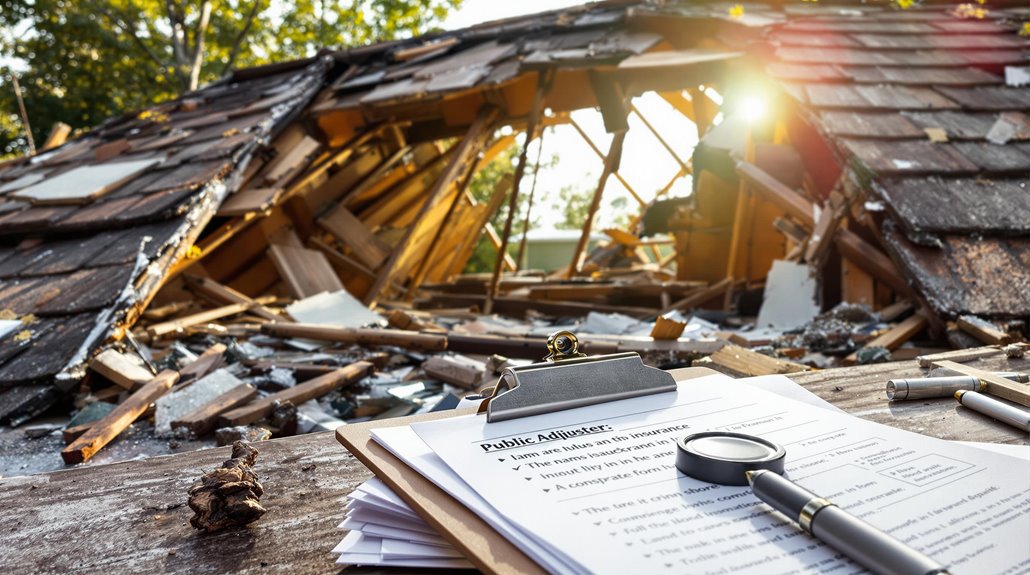
Consulting a public adjuster offers distinct advantages in the insurance claims process.
Their expertise in steering complex claims, paired with objective damage assessments, enables a streamlined claim process that is more likely to result in higher claim payouts and settlements.
Studies demonstrate that claims handled by public insurance adjusters consistently achieve up to 800% higher settlement amounts compared to unrepresented claims.
Expertise In Insurance Claims
How can property owners secure they receive a fair insurance settlement after structural damage occurs? Leveraging the expertise of public adjusters in insurance claims is essential. Public adjusters work on behalf of policyholders to make certain that all damages, including hidden structural issues, are thoroughly documented and accurately assessed. Working with pre-vetted licensed adjusters through networks like PCAN ensures access to qualified professionals with proven track records and strict ethical standards.
Benefits of Public Adjusters’ Expertise:
- In-depth policy knowledge: Public adjusters understand policy nuances, enabling them to navigate complex claims processes effectively.
- Accurate damage assessment: They thoroughly document and assess all damages, including structural systems, to guarantee accurate payouts.
- Effective advocacy: Public adjusters possess knowledge of local building codes and regulations, advocating for necessary repairs and compliance requirements.
- Time and stress savings: They handle negotiations with insurance companies, allowing property owners to focus on recovery and repairs.
Objective Damage Assessment
When a property sustains structural damage, the accuracy of the damage assessment plays a crucial role in determining the outcome of the insurance claim.
The first step towards achieving an objective damage assessment is consulting a public adjuster. Possessing specialized knowledge and expertise in evaluating structural damage and estimating repair costs, public adjusters can greatly enhance the accuracy of damage assessments.
By advocating for policyholders, public adjusters guarantee that insurance claims are thoroughly documented and that property owners receive fair compensation for both visible and hidden damages.
This expertise ultimately leads to more accurate and thorough assessments, providing a solid foundation for successful insurance claims. Consulting a public adjuster is a critical step in traversing the complex claims process.
Streamlined Claim Process
Numerous benefits arise from utilizing the expertise of a public adjuster, particularly regarding streamlining the claim process. Their specialized knowledge enables efficient navigation of complex policy details, maximizing insurance payouts for various types of damage.
Key benefits of consulting a public adjuster for a streamlined claim process include:
- Expert damage documentation: Thorough reports and evidence strengthen the claim, facilitating quicker approvals from insurance companies.
- Time and stress savings: Public adjusters handle negotiations and communications, allowing property owners to focus on recovery efforts.
- Identification of hidden damages: Public adjusters guarantee all aspects of the loss are accounted for in the claim.
- Efficient claim resolution: Specialized knowledge enables public adjusters to expedite the claims process, resulting in faster payouts.
Higher Claim Payouts & Settlements
The expertise of a public adjuster not only streamlines the claim process but also greatly impacts the claim payout amount. Consulting a public adjuster can result in higher claim payouts due to their expertise in accurately evaluating damage and negotiating with insurance companies.
Studies have shown that public adjusters typically secure settlements 20-50% higher than those offered by insurance companies. This is achieved through a thorough documentation process, including photos and detailed reports, which strengthens the claim and increases the likelihood of approval.
About The Public Claims Adjusters Network (PCAN)
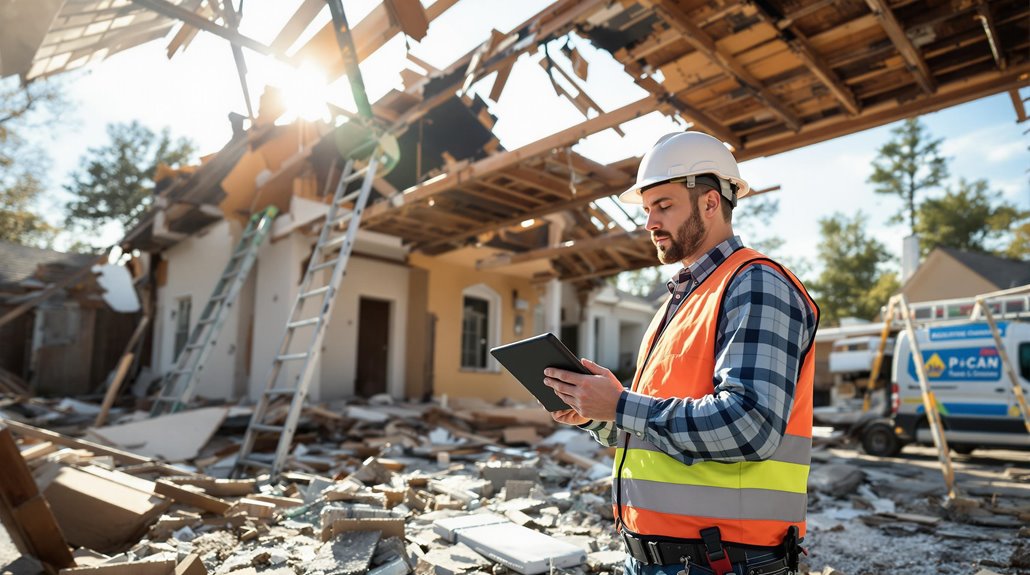
Specializing in residential and commercial property damage insurance claims, a national network of pre-vetted, verified, and state-licensed public adjusters has emerged as a valuable resource for policyholders.
The Public Claims Adjusters Network (PCAN) serves as a resource for policyholders to connect with expert public adjusters.
Some of the key benefits of the Public Claims Adjusters Network (PCAN) include:
- Expertise: PCAN member adjusters are experts in over 30 different claim types.
- Nationwide Reach: PCAN member adjusters are located in 40+ states.
- High Standards: All PCAN member adjusters are held to the highest standards of ethics, morals, and professionalism.
- Yearly Audits: Mandatory yearly audits are conducted on licenses and complaints to guarantee early detection of any issues.
Frequently Asked Questions
Does FEMA Pay for Structural Damage?
FEMA astonishingly pays out massive sums for structural damage, with financial assistance reaching upwards of $41,400 through the Individuals and Households Program, given the damage meets specified criteria for FEMA assistance eligibility.
What Would Be Considered Structural Damage?
Structural damage encompasses foundation issues, such as cracks, shifting, or settling, and affects load-bearing components, including walls, beams, and roofs, compromising the building’s integrity and safety, often caused by environmental factors or seismic activity.
What Does Mitigation Mean in an Insurance Claim?
Approximately 25% of insurance claims are denied due to inadequate mitigation efforts. In an insurance claim, mitigation refers to the implementation of strategies to minimize damage and prevent further losses, thereby reducing the claim’s overall cost.
How Do You Assess Structural Damage?
Evaluating structural damage involves conducting a thorough damage assessment, including visual inspections and evaluations by licensed professionals, to identify reductions in load-bearing capacities and determine the extent of damage, in accordance with established codes and criteria.
